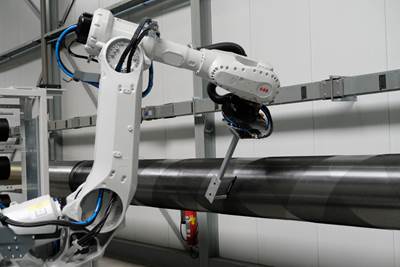Composites Use in Pressure Vessels
High-pressure gas storage vessels represent one of the largest and fastest-growing markets for advanced composites, particularly for filament-wound carbon fiber composites. Although they are used in self-contained breathing apparatuses and provide oxygen and gas storage on aerospace vehicles, the primary end markets are for storage of liquid propane gas (LPG), compressed natural gas (CNG), renewable natural gas (RNG) and hydrogen gas (H2).

Latest Pressure Vessels Articles
VIEW ALLVestas to repurpose Isle of Wight facility for U.K. onshore blades
Transition from offshore to onshore wind blade production will support the U.K.’s focus on building domestic supply chains, increasing demand.
Read MoreORNL demonstrates lightning strike protection tech for composites
Researchers, led by Vipin Kumar, developed a low-cost, recyclable carbon fiber wind turbine blade tip that showed resilience to high-voltage lightning strikes, with more innovations in store.
Read MoreNew Flyer selects Hexagon Purus H2 tanks for fifth consecutive year
Type 4 tanks will continue to be supplied for the mass mobility provider’s Xcelsior Charge FC fuel cell electric transit buses.
Read MoreHexagon Agility receives wave of RNG fuel system orders for Class 8 trucks
RNG/CNG fuel system installations with Type 4 CFRP pressure vessels, powered by Cummins’ 15-liter natural gas tank, adds 230,000 heavy-duty trucks to the addressable RNG/CNG market annually.
Read MoreORPC Ireland, Queen’s begin X-Flow project for hydrokinetic turbine testing
Deployment of CFRP turbine technology to Strangford Lough will provide insight into blade and rotor performance, predictive maintenance and grid-scale benefits of tidal energy using real tide conditions.
Read MoreGraphmatech launches Aros polyamide-graphene for Type 4 tanks, secures grant
Combination of polyamide grades and graphene introduces low-permeation solution for upscaling H2 storage, transport applications.
Read MoreKnowledge Centers

During CW Tech Days: Thermoplastics for Large Structures, experts explored the materials and processing technologies that are enabling the transition to large-part manufacturing.
LEARN MORELatest Pressure Vessels News And Updates
Gurit announces strategic alignment to preserve wind leadership, accelerate growth in other markets
While expected wind business revenue did not materialize for Q3 2024, Gurit is actively implementing measures to diversify its portfolio and position it for a wind sale increase in 2025.
Read MoreECORES WIND builds on wind blade circularity initiatives
Latest Horizon Europe project seeks to introduce innovative circular resins combined with advanced disassembly strategies, enabling cost-effective blade decommissioning and material reuse.
Read MoreMingYang completes 20-MW offshore wind turbine installation
The MySE18.X-20MW, located in China, becomes the largest single-capacity offshore wind turbine on the market.
Read MoreMikrosam equips BTU Germany with single-tape AFP head for Type 5 pressure vessels
Delivery of upgraded placement head provides additional automated layup flexibility, quality control for the university’s latest projects advancing Type 4 and 5 hydrogen storage.
Read MoreBlueWind secures contract with GE Vernova to manufacture wind turbine nacelle covers
With more than 2,000 2X nacelle covers manufactured, the company expands its supply with the WT20 model
Read MoreCorPower Ocean secures funding to commercialize wave energy
CorPower Ocean announces significant investment in its wave energy technology that converts its motion into electricity via a filament-wound fiberglass buoy design.
Read MoreFeatured Posts
Composites reinvent energy
Celebrating National Composites Week 2024, CW looks at how composites are being used to provide the next generation of energy.
WatchComposites reinvent infrastructure
Celebrating National Composites Week, CW shares ways in which composites continue to evolve the way we approach infrastructure projects.
Read MoreComposites end markets: Automotive (2024)
Recent trends in automotive composites include new materials and developments for battery electric vehicles, hydrogen fuel cell technologies, and recycled and bio-based materials.
Read MoreAchieving composites innovation through collaboration
Stephen Heinz, vice president of R&I for Syensqo delivered an inspirational keynote at SAMPE 2024, highlighting the significant role of composite materials in emerging technologies and encouraging broader collaboration within the manufacturing community.
Read MoreComposites end markets: Batteries and fuel cells (2024)
As the number of battery and fuel cell electric vehicles (EVs) grows, so do the opportunities for composites in battery enclosures and components for fuel cells.
WatchOptimizing robotic winding of composite tanks and pipes
Pioneer in mandrel-based reinforced rubber and composite products, TANIQ offers TaniqWindPro software and robotic winding expertise for composite pressure vessels and more.
WatchFAQ: Pressure Vessels
How are composites used in energy storage?
Composites are used to build pressure vessels to store compressed natural gas, liquid propane gas, hydrogen gas.
These typically involve filament winding of glass or carbon fiber around a metal, plastic or all-composite liner.
What are the types of pressure vessels?
You may see pressure vessels or storage tanks listed as one of various numbered “Types.”
Pressure vessels are organized into five types:
-
-
- Type I: All-metal construction, generally steel.
- Type II: Mostly metal with some fiber overwrap in the hoop direction, mostly steel or aluminum with a glass fiber composite; the metal vessel and composite materials share about equal structural loading.
- Type III: Metal liner with full composite overwrap, generally aluminum, with a carbon fiber composite; the composite materials carry the structural loads.
- Type IV: An all-composite construction, polymer — typically polyamide (PA) or high-density polyethylene (HDPE) liner with carbon fiber or hybrid carbon/glass fiber composite; the composite materials carry all the structural loads.
- Type V: Linerless, all-composite construction.
-
Do composites have a role in the hydrogen economy?
For years, composites have offered lightweight storage of compressed hydrogen (H2) gas for zero-emission, fuel cell-powered vehicles via Type IV tanks comprising plastic liners wrapped with carbon fiber and epoxy resin. Though H2 has long promised a sustainable source of clean energy, until recently, progress was slow.
As the market continues to grow, demand for Type IV tanks continues to increase, with new technologies in development.
Follow CompositesWorld’s continuing hydrogen market coverage for the latest.
Source: The potential for hydrogen to fuel composites growth











.jpg;maxWidth=300;quality=90)



















